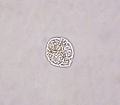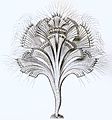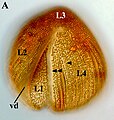Cercozoa
| Cercozoa | |
|---|---|

| |
Cercomonas
| |
| Scientific classification | |
| Domain: | Eukaryota |
| Clade: | Diaphoretickes |
| Clade: | SAR |
| Clade: | Rhizaria |
| Phylum: | Cercozoa |
| Classes | |
| |
| Synonyms | |
| |
Cercozoa (now synonymised with Filosa)
Characteristics
The group includes most
Diversity
Some cercozoans are grouped by whether they are "filose" or "reticulose" in the behavior of their cytoskeleton when moving:[10]
- Filose, meaning their pseudopods develop as filopodia. For example:
- siliceousscales or plates, which are commonly found in soils, nutrient-rich waters, and on aquatic plants.
- Gromia, a shelled amoeba.
- Tectofilosids, filose amoebae that produce organic shells.
- Cercomonads, common soil-dwelling amoeboflagellates.
- Reticulose, meaning they form a reticulating net of pseudopods. For example:
- Chlorarachniophytes, set apart by the presence of chloroplasts bound by four membranes and still possess a vestigial nucleus, called a nucleomorph. As such, they have been of great interest to researchers studying the endosymbiotic origins of organelles.
Other important ecological groups are:
- Gymnosphaerida.[10]
- Phaeodaria, marine protozoa previously considered radiolarians.[11]
Ecology
As well as being highly diverse in
Soil-dwelling cercozoans are one of the dominant groups of free-living eukaryotic microorganisms found in
Some cercozoa are coprophilic or
Cercozoan
Evolution
External evolution
| Paraphyletic Cercozoa[2] |
| Monophyletic Cercozoa[15] |
Originally, Cercozoa contained both Filosa and
However, the monophyly of the group was still uncertain. Posterior multigene phylogenetic analyses consistently found Cercozoa to be paraphyletic, because Endomyxa clustered next to Retaria instead of Filosa.[17][18][19] Because of this, Endomyxa was excluded from Cercozoa, which became a synonym of Filosa.[2]
More recent phylogenomic analyses with better sampling recovered a sister relationship between Filosa (=Cercozoa) and Endomyxa once again,[15] although the modern classification of eukaryotes retains Endomyxa, Cercozoa and Retaria as separate phyla within Rhizaria.[20]
Internal evolution
The phylum Cercozoa previously contained both Filosa and
| Cercozoa |
| ||||||||||||
A more recent
In addition to the known
Classification
The classification of Cercozoa was revised in 2018:[2]
- Subphylum Reticulofilosa Cavaler-Smith 1997
- Class Chlorarachniophyceae)
- Class Granofilosea Cavalier-Smith & Bass 2009
- Class Skiomonadea Cavalier-Smith 2012
- Class
- Subphylum Monadofilosa Cavalier-Smith 1997
- Superclass Eoglissa Cavalier-Smith 2011 emend. 2018
- Class Metromonadea Cavalier-Smith 2007
- Class HelkeseaCavalier-Smith 2018
- Superclass Ventrifilosa Cavalier-Smith 2012 emend. 2018
- Class Sarcomonadea Cavalier-Smith 1993 emend. 2018
- Class Imbricatea Cavalier-Smith 2003 emend. 2018
- Class Thecofilosea Cavalier-Smith 2003 emend. 2012
- Superclass Eoglissa Cavalier-Smith 2011 emend. 2018
Gallery
-
Cercomonas sp. (Cercozoa:Cercomonadida)
-
Ebria sp. (Cercozoa:Ebridea)
-
Rhipidodendron sp. (Cercozoa:Spongomonadea)
-
Euglypha sp. (Cercozoa: Euglyphida)
-
Phaeodarians (Cercozoa: Phaeodarea)
-
Desmothoracida)
-
Chlorarachniophyta)
-
Vampyrella sp. (Cercozoa: Vampyrellidae)
-
Gromiidea)
-
Auranticordis (Cercozoa: Marimonadida)
References
- S2CID 6557779.
- ^ PMID 29666938
- ISSN 0003-9365.
- PMID 15148395.
- PMID 16730229.
- ^ Chantangsi, C. (2009). Comparative morphology and molecular evolution of marine interstitial cercozoans. PhD thesis. University of British Columbia.
- ^ "SYSTEMATIC BIOLOGY: CERCOZOA". Archived from the original on 2015-04-02. Retrieved 2009-03-28.
- ^ PMID 15545489.
- PMID 14658494.
- ^ PMID 18952499.
- PMID 26083083.
- ^ PMID 26953604.
- PMID 26914587.
- PMID 28618206.
- ^ S2CID 52982396.
- ^ PMID 21295519.
- S2CID 8257631.
- PMID 21126361.
- PMID 28333264.
- PMID 30257078.
- PMID 29658156.
External links
- Tree of Life Cercozoa
- phylogeny of Phaeodarea










